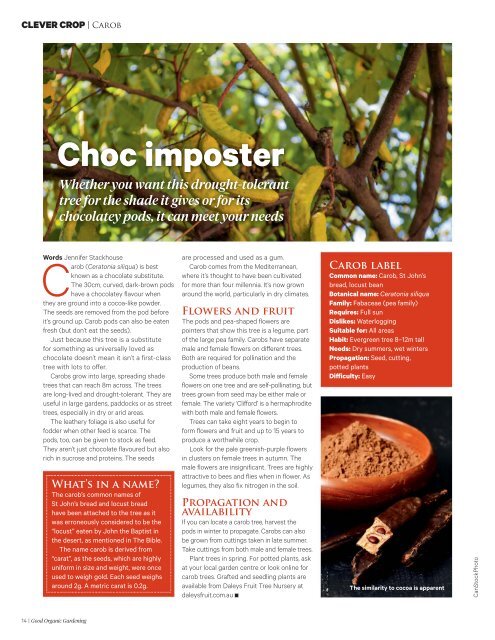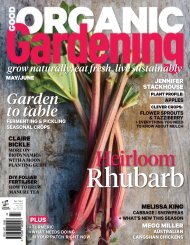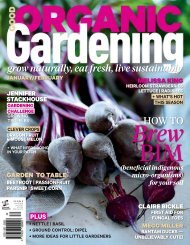6. Good Organic Gardening - November-December 2016 AvxHome.in
6. Good Organic Gardening - November-December 2016 AvxHome.in
6. Good Organic Gardening - November-December 2016 AvxHome.in
You also want an ePaper? Increase the reach of your titles
YUMPU automatically turns print PDFs into web optimized ePapers that Google loves.
CLEVER CROP | Carob<br />
Choc imposter<br />
Whether you want this drought-tolerant<br />
tree for the shade it gives or for its<br />
chocolatey pods, it can meet your needs<br />
Words Jennifer Stackhouse<br />
Carob (Ceratonia siliqua) is best<br />
known as a chocolate substitute.<br />
The 30cm, curved, dark-brown pods<br />
have a chocolatey flavour when<br />
they are ground <strong>in</strong>to a cocoa-like powder.<br />
The seeds are removed from the pod before<br />
it’s ground up. Carob pods can also be eaten<br />
fresh (but don’t eat the seeds).<br />
Just because this tree is a substitute<br />
for someth<strong>in</strong>g as universally loved as<br />
chocolate doesn’t mean it isn’t a first-class<br />
tree with lots to offer.<br />
Carobs grow <strong>in</strong>to large, spread<strong>in</strong>g shade<br />
trees that can reach 8m across. The trees<br />
are long-lived and drought-tolerant. They are<br />
useful <strong>in</strong> large gardens, paddocks or as street<br />
trees, especially <strong>in</strong> dry or arid areas.<br />
The leathery foliage is also useful for<br />
fodder when other feed is scarce. The<br />
pods, too, can be given to stock as feed.<br />
They aren’t just chocolate flavoured but also<br />
rich <strong>in</strong> sucrose and prote<strong>in</strong>s. The seeds<br />
What’s <strong>in</strong> a name?<br />
The carob’s common names of<br />
St John’s bread and locust bread<br />
have been attached to the tree as it<br />
was erroneously considered to be the<br />
“locust” eaten by John the Baptist <strong>in</strong><br />
the desert, as mentioned <strong>in</strong> The Bible.<br />
The name carob is derived from<br />
“carat”, as the seeds, which are highly<br />
uniform <strong>in</strong> size and weight, were once<br />
used to weigh gold. Each seed weighs<br />
around 2g. A metric carat is 0.2g.<br />
are processed and used as a gum.<br />
Carob comes from the Mediterranean,<br />
where it’s thought to have been cultivated<br />
for more than four millennia. It’s now grown<br />
around the world, particularly <strong>in</strong> dry climates.<br />
Flowers and fruit<br />
The pods and pea-shaped flowers are<br />
po<strong>in</strong>ters that show this tree is a legume, part<br />
of the large pea family. Carobs have separate<br />
male and female flowers on different trees.<br />
Both are required for poll<strong>in</strong>ation and the<br />
production of beans.<br />
Some trees produce both male and female<br />
flowers on one tree and are self-poll<strong>in</strong>at<strong>in</strong>g, but<br />
trees grown from seed may be either male or<br />
female. The variety ‘Clifford’ is a hermaphrodite<br />
with both male and female flowers.<br />
Trees can take eight years to beg<strong>in</strong> to<br />
form flowers and fruit and up to 15 years to<br />
produce a worthwhile crop.<br />
Look for the pale greenish-purple flowers<br />
<strong>in</strong> clusters on female trees <strong>in</strong> autumn. The<br />
male flowers are <strong>in</strong>significant. Trees are highly<br />
attractive to bees and flies when <strong>in</strong> flower. As<br />
legumes, they also fix nitrogen <strong>in</strong> the soil.<br />
Propagation and<br />
availability<br />
If you can locate a carob tree, harvest the<br />
pods <strong>in</strong> w<strong>in</strong>ter to propagate. Carobs can also<br />
be grown from cutt<strong>in</strong>gs taken <strong>in</strong> late summer.<br />
Take cutt<strong>in</strong>gs from both male and female trees.<br />
Plant trees <strong>in</strong> spr<strong>in</strong>g. For potted plants, ask<br />
at your local garden centre or look onl<strong>in</strong>e for<br />
carob trees. Grafted and seedl<strong>in</strong>g plants are<br />
available from Daleys Fruit Tree Nursery at<br />
daleysfruit.com.au<br />
Carob label<br />
Common name: Carob, St John’s<br />
bread, locust bean<br />
Botanical name: Ceratonia siliqua<br />
Family: Fabaceae (pea family)<br />
Requires: Full sun<br />
Dislikes: Waterlogg<strong>in</strong>g<br />
Suitable for: All areas<br />
Habit: Evergreen tree 8–12m tall<br />
Needs: Dry summers, wet w<strong>in</strong>ters<br />
Propagation: Seed, cutt<strong>in</strong>g,<br />
potted plants<br />
Difficulty: Easy<br />
The similarity to cocoa is apparent<br />
CanStockPhoto<br />
14 | <strong>Good</strong> <strong>Organic</strong> <strong>Garden<strong>in</strong>g</strong>

















